For Positive Results in the Radiology Workplace, Train the Leaders in Social Integrity
Leadership program emphasizing communication reduced burnout and improved engagement


When radiology department leaders are trained in positive leadership, their team members are less likely to experience burnout, are more engaged with their work, and are less likely to think about leaving.
A study published in Radiology details how employees in a breast imaging unit reported a more positive workplace climate after their leaders participated in a program that emphasizes kindness, compassion, forgiveness, integrity and courage.
“How we interact with others matters,” said lead author Amy Young, PhD, professor of business communications at the Ross School of Business and adjunct research professor of radiology at Michigan Medicine in Ann Arbor. “We know that incivility in the workplace activates the sympathetic nervous system and contributes to workplace stress, mental fatigue, decreased productivity, and turnover.”
These consequences represent the “negative deviance” side of social interactions, Dr. Young explained. Her research and scholarly work focuses on the beliefs and behaviors that enhance performance at the individual and organizational level. And there’s a “positive deviance” side as well, she noted, which can increase resilience, cognitive abilities, collaboration and productivity.
"Although many factors are at play in workplace dynamics, the strong association between leadership communication and positive workplace climate—and, subsequently, between positive workplace and other survey issues—highlights the critical role that communication plays in effective leadership overall."
JAMES H. THRALL, MD
Strong Leadership Communication Associated With Positive Workplace Climate
Dr. Young’s team applied these principles to a study of approximately 90 health care workers in the radiology department’s breast imaging unit at Michigan Medicine. They surveyed workers before implementing a positive leadership program in 2021, and again two years after implementation.
Faculty and staff were asked about their perceptions of leaders, their workplace environment, their personal engagement with the job, burnout and intent to leave.
“We first conducted regressions and path analyses with data collected prior to the program to understand the associations among leadership behaviors, workplace climate, and the outcomes of burnout, engagement and turnover,” Dr. Young said. “We also collected data following the program to identify change that occurred from the beginning to the end of the program.”
The training was based on a model proposed in the early 2000s by Kim Cameron, emeritus professor at the University of Michigan’s Ross School of Business.
“Based on his empirical work, Professor Cameron found that leadership behaviors emphasizing virtues and character strengths not only improved organizational performance but also increased the energy of others,” Dr. Young said.
Leaders who participated in the training were physicians, nurses, technologists, clerical administrators and information technology support staff. They began with background reading and progressed through a series of focused presentations covering 15 attributes of positive leadership based on five groups of principles: kindness, compassion, forgiveness, integrity and courage.
When the research team surveyed workers again in 2023, they observed improvements across the board, including statistically significant changes in satisfaction with leadership communication, positive workplace climate, decreased burnout and heightened engagement.
The researchers found that a positive workplace climate was negatively correlated with burnout and intent to leave and positively correlated with engagement.
“High workplace engagement is critical during organizational crises, as much of the crisis management falls to the frontline health care workers who are called to adapt to limited resources, brainstorm workarounds and coordinate the execution of a new plan,” the authors write.
Team Approach, Feedback and Mentoring Building Blocks for Effective Leadership
In an accompanying editorial, James H. Thrall, MD, chairman emeritus of the Department of Radiology, Massachusetts General Hospital, and the Distinguished Taveras Professor of Radiology, Harvard Medical School, both in Boston, commented on the statistical significance of these changes. He illuminated some factors that might contribute to one element that improved but didn’t reach statistical significance: intent to leave.
“It should be noted that many academic departments experience high turnover among younger faculty and employees for understandable reasons,” Dr. Thrall said. “It is common for people to stay on staff after their training to gain more experience, while waiting for a spouse or significant other to finish a program, or while waiting for their ideal job to become available.”
The anonymous nature of the surveys precludes capturing workers’ specific reasons for leaving, Dr. Thrall noted, and he suggested that the topic could serve as a subject for future research.
Dr. Young’s team plans to expand the scope of their study.
“This was a pilot study to demonstrate the value of bringing a well demonstrated approach from management science to the medical field,” she said. “We will run the program again with a larger cohort, comparison group and network analysis to allow for more conclusive results.”
Meanwhile, the approach and findings of Dr. Young’s team yield important insights into the key building blocks that should be part of effective leadership programs, Dr. Thrall said.
“Although many factors are at play in workplace dynamics, the strong association between leadership communication and positive workplace climate—and, subsequently, between positive workplace and other survey issues—highlights the critical role that communication plays in effective leadership overall,” he said. “Absent effective communication, all other aspects of leadership falter. How to communicate effectively should be a centerpiece, if not the centerpiece, of leadership development programs.”
For More Information
Access the Radiology study, “Positive Leadership within Breast Imaging: Impact on Burnout, Intent to Leave, and Engagement.”
Read previous RSNA News articles on breast imaging: